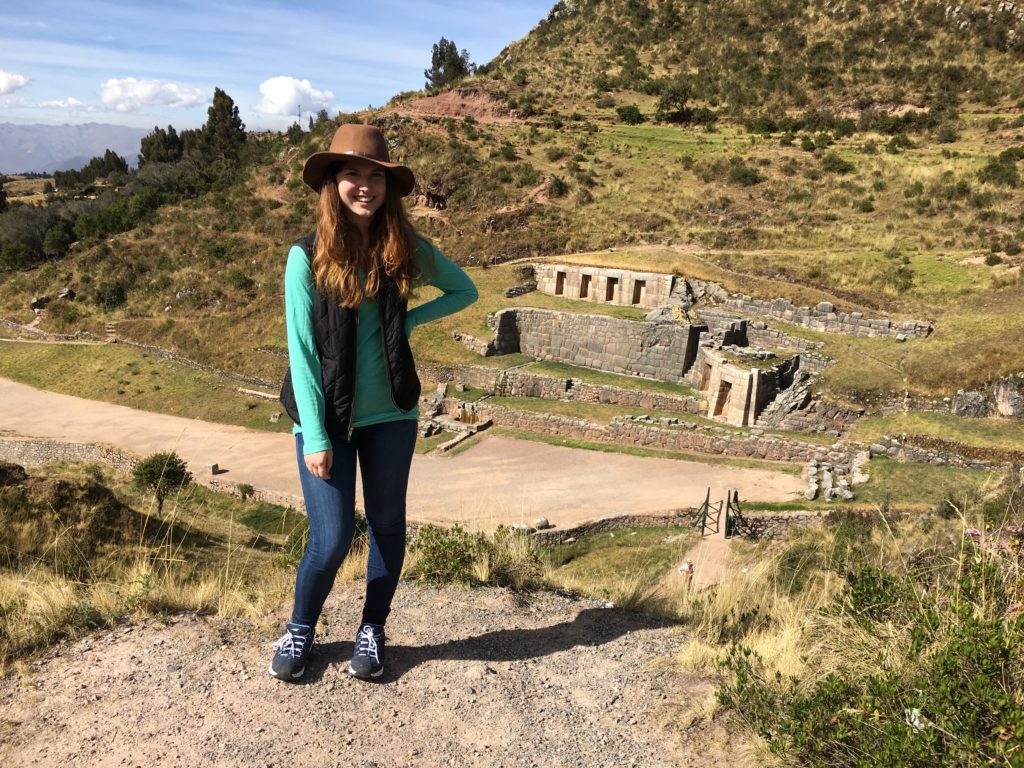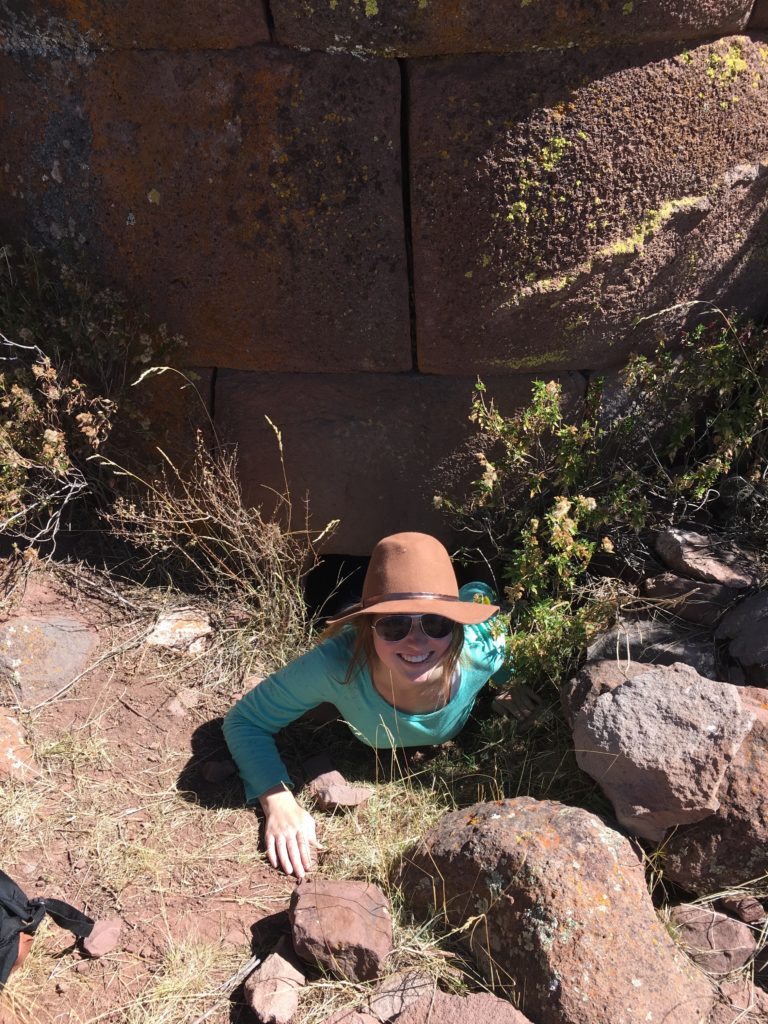
When people find out that I am an archaeologist they often respond with “oh that’s so cool! I’ve never met an archaeologist before,” which is generally followed up by the question “what’s it like to be an archaeologist?” While it often depends on the site that I am working on, here is a description of an average day in the field.
5:30-6:00 a.m. Wake-up: While I’m a morning person to begin with, we generally start my days in the field pretty early so that we don’t work too long in the strong afternoon sun. I’m currently working in rural Peru and find the roosters our hospedaje owner keeps work as an excellent alarm clock.
6:30 a.m. Dressed & Breakfast: During the year when I am out of the field, I love spending time each morning deciding which chunky costume jewelry I should wear with my blazer and ballet flats, but when I’m in the field I’m far less concerned with my clothes. I typically wear jeans, a t-shirt, and a flannel over the top with a big hat to help block the sun (and to look a little like Indian Jones). If it’s chilly I’ll wear a vest, but an hour into work I’ll be hot from excavating and will take it off. Breakfast in the field varies dramatically based on where I am. Currently in Peru I’m surrounded by deliciously fresh avocados, so I’ve been eating avocado sandwiches made on freshly baked chapla bread most mornings. However, if I know I’m going to be seriously working up an appetite one morning I’ll opt for something higher in protein like fruit, yogurt, and granola.
7:00a.m. Heading to the field: Transportation varies widely based upon site location, but currently I am living about a fifteen-minute car-ride to the site. Generally, we have a driver pick us up in his former combi (a large passenger van that operates as a bus) to drop us off to the site. However, on days when he is busy, we take an operational combi to the nearest stop and walk the last ten-minutes to the site. The site I’m excavating is downhill from the combi stop and I adore the walk down in the mornings, because it gives me time to get into the excavation mindset, but the walk uphill at the end of the day can feel brutal.
7:30a.m.-12:00p.m. Morning Work: Morning work generally includes shooing away animals, excavations, drawing maps of the excavation units (my least favorite activity), paperwork and drone photographing excavations. The site I’m working at currently is surrounded by farmlands and we frequently have cows, donkeys, and sheep wander in and make themselves at home when we aren’t there. While I love animals and wish they could stay, excavations are dangerous places for animals, because if they step wrong in an excavation unit they could break their ankle so we have to take them home before we can start for the day. Additionally, some animals get nervous around the drone, because of the noises it makes, and we don’t want them to be unnecessarily scared. I love taking drone photos frequently of the entire site and putting them together to see the progress that is being made at a site.

12:00-1:00p.m. Lunch: After four hours of excavation I’m always very excited for lunchtime. Field lunches need to be preserved during the morning sitting at the site and currently the site I’m at does not have great shade to hide our lunch bag. Therefore, I’ve been eating many tuna sandwiches made with crema de aji instead of mayonnaise with potato chips, a mandarin, and a set of cookies. Anytime I work in Peru I try to incorporate crema de aji into my lunch, because it is one of my favorite condiments and I can’t find it easily in the United States. After I eat I try to catch up on my field notes which outline what everyone has been doing during the morning, my observations about our findings and things I want to do in the afternoon.
1:00-4:00p.m. Afternoon Work: Afternoon work is the same as morning work. While it depends on the site director if you can play music in the field, I’m currently the site director and am pro-music in the field, especially to help energize the afternoon excavations. Currently, I’m playing a lot of reggaetón but my general go-to is pop/alt. music from the 2000s (think Jonas Brothers, Fergie, and Fall Out Boy).
4:00-4:30p.m. Clean-up Excavations & Ride Home: As I mentioned above, the site has many four-legged visitors while we are gone, so we need to make the site as safe as possible for them. This generally means covering all open units securely with tarps, making sure all equipment is put away safely, and packing all artifacts up with us to take to our make-shift field lab.
4:30-6:00p.m. “De-field”: This time is generally filled with showers, beers, and snacks. Although it is gross, when I don’t have access to hot showers every day, I will forgo a daily shower for one every few days with a wipes “shower” for the days in between. Regardless of the shower situation I’ll change out of my gross field clothes into leggings, a sweater, fuzzy socks, and moccasins to lounge in and to wash artifacts after dinner. After working all day in the field beers and snacks are calorically needed and people generally gather around the table as their finished with their showers to chat and play cards.
6:00-7:00p.m. Dinner: Dinnertime and meals vary greatly based upon site, but currently we eat dinner around 6. We are staying at an hospedaje and don’t have access to a kitchen, so we have to eat out every night in a town that has two small restaurants. Therefore, we have to get there when it opens to make sure we snag a table, if not, it’s street salchipollo, which while I love Nancy’s salchipollo, it isn’t always filling enough after a day in the field. Both restaurants in town have set menus for the day which vary quite a bit, but because we are in Peru there are always two starches on your plate to help refuel your body for excavations the next day.
7:00-9:00p.m. Wash Artifacts & Hangout: Almost every artifact that comes out of the ground needs to be washed and this can be an overwhelming process if you wait until the end of the season to do it, but by washing some artifacts every night it is quite manageable. Some nights artifact washing is accompanied by music and conversation, but other nights when we’re all tired we watch a movie while we wash.
9:00-? p.m. Hangout & Bedtime: As I said I’m a morning person, so by 9:30-10 on excavation days I’m ready for bed. I normally wind down by reading a Nicholas Sparks book for some semi-mindless entertainment before bed.
What questions do you have for me about the life of an archaeologist?
-Maria Smith
Junior Girl
Girl Museum Inc.
